TWO-STROKE TUESDAY | THE IN’S & OUT’S OF THE 2005 KX250
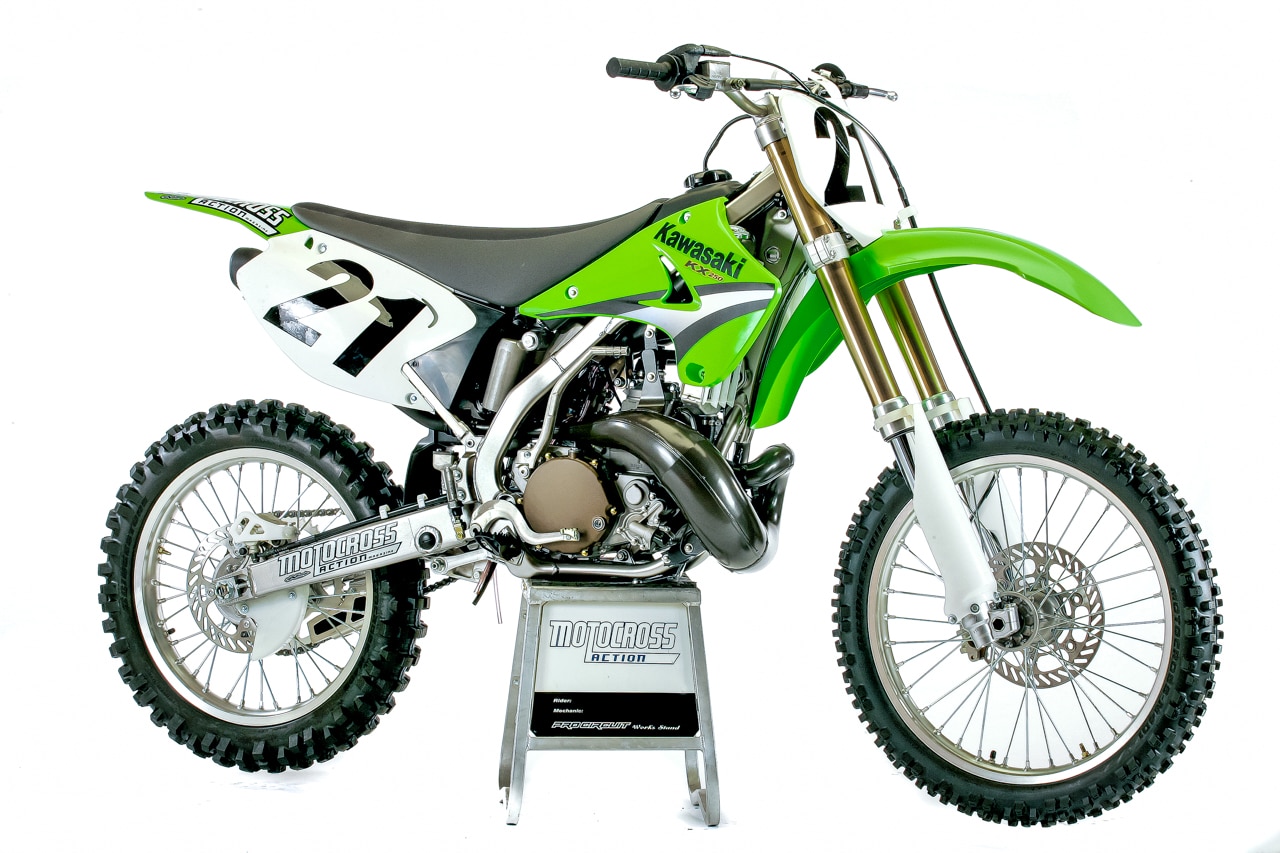 This archived 2005 Kawasaki KX250 test was from the January 2005 issue of MXA.
This archived 2005 Kawasaki KX250 test was from the January 2005 issue of MXA.
We wouldn’t be telling tales out of school if we said that every MXA test rider we assigned the 2004 Kawasaki KX250 to was disgruntled. Oh, like all good test riders, they would do their duty, but they whined, groused and begged for a different assignment. They didn’t like it—in the least—and weren’t ashamed to make their feelings known.
It wasn’t always so. There was a time, not so long ago, when MXA test riders fought to be allowed to race the KX250. From 1997 to 1999, the KX250 dominated the charts. It was the MXA Bike of the Year for three straight years. It was a smash hit. But, Kawasaki lost its way. They made the wrong choices, let R&D lag and suffered the consequences.
But every year is a new year. Will the 2005 KX250 regain the love of the finicky test riders?
Q: IS THE 2005 KX250 ENGINE FASTER THAN LAST YEAR?
A: Yes. Beyond a shadow of a doubt. But let’s not get too misty about the 2005 KX250 being faster than the ’04 model. For the past few years (2001-2004), the KX250 has been lucky to crack 43 horsepower—while every other bike was pushing 46 ponies. In our dyno runs, the 2005 KX250 topped 47 horsepower. Hallelujah!
Q: IS IT FAST OR SLOW?
A: Here is a quote from last year’s KX250 test in response to the same question: “It is slow. It is better than it was, but the best adjective to describe the KX250’s potential is average.”
So what do we think about the ‘05? It is fast.
Q: WHAT IS THE POWERBAND LIKE?
A: The ‘05 KX250 is a mid-and-up engine. Low-end power is not part of the equation. It is a gun-and-run engine; you hammer it hard in the midrange, let it rev and then slam in another gear. There are no quarter-throttle or half-throttle solutions to track situations. You go all out or you don’t go.
Q: HOW DOES IT COMPARE TO THE YZ250 AND RM250?
A: It should be noted that all of these bikes share a 2005 Yamaha YZ250 engine—not literally, but philosophically. The 2005 Suzuki RM250 and Kawasaki KX250 owe a debt of gratitude to the Yamaha engineering department because, to the trained eye, the green and yellow engines are clones.
That said, the three engines have very distinct powerband characteristics.
Yamaha YZ250: The YZ250 has the broadest powerband, the most low-end and feels the torquiest. In many ways, the YZ250 delivers the most power for the money (although it does not make the most peak horsepower by a full horse).
Suzuki RM250: The RM250 lacks the torque and broadness of the YZ, but it makes up for it in quickness, acceleration and punch. It has a thrill-ride powerband. Because it starts later than the YZ250 (the YZ makes 30 horsepower from 5700 rpm to 9700, while the RM doesn’t crack 30 until 6600 rpm), the Suzuki feels like it signs off sooner than the YZ. Not so. The RM250 actually revs farther than the broader feeling YZ.
Kawasaki KX250: The Kawasaki’s powerband is closer to the RM250’s than the YZ250’s. It lacks the usable low-end of the YZ, but its power curve mimics the RM250’s later start and longer pull. Unfortunately, the YZ and RM are so good at what they do, that the KX250 has to play second fiddle to both of them. (Wouldn’t that be third fiddle?) It doesn’t have the quickness of the RM in the middle, but it pulls very hard near peak and matches the RM250 pony for pony on top.
Q: WHAT ABOUT THE KX250 GEARING?
A: Bad. Previous Kawasaki KX250s suffered from a large gap between second and third gear. The 2005 model is no different. With the stock gearing, it falls on its face with every upshift. It’s horrid. We added one tooth to the rear sprocket (from 51 to 52) to lessen the chasm. We tried 53 teeth, but it put the kibosh on second gear by making it too short.
Q: HOW GOOD IS THE SHIFTING?
A: The shifting would be good if we could find the shift lever. Every MXA test rider complained that the KX’s shift lever was tucked in so far that it felt short. Additionally, the clutch had a draggy feel, felt jerky when cold and didn’t like the abuse required to carry third out of a corner.
Q: WHAT ABOUT THE 2005 KX250 SUSPENSION?
A: In actuality, that question should read “What about the 2005 YZ250 suspension?” Kawasaki and Yamaha are sharing Kayaba’s new “Showaba” forks. And since Kawasaki went to a Yamaha-style rear shock linkage last year, the transformation is complete.
Forks: In 2002, Kawasaki had Kayaba bladder forks. In 2003, Kawasaki made the transition to the old-school Kayaba bumper forks. In 2004, they retreated from the bumper forks to something they called “semi-sealed cartridge forks.” For 2005, they have upgraded to totally sealed cartridge forks—Kayaba’s take on Showa’s Twin-Chamber design. Although there are differences between Yamaha’s and Kawasaki’s versions of the Showabas, they are miniscule. We liked this fork on the 2005 YZ250, and we like it on the 2005 Kawasaki KX250. The average rider should start with the compression on 12 out and the rebound on 10 out.
Shock: The biggest difference between this year’s rear suspension and last year’s is a rising rate change. The rear suspension was decent. It absorbed most big landings and was only a little chattery on the small stuff. We would have liked to have had the ability to adjust the high-speed compression, but Kawasaki dropped that innovation two years ago (after pioneering it). We set the race sag at 100mm and the low-speed clicker on 12 out. Rebound varied from eight to ten clicks out.
Q: HOW DOES IT HANDLE?
A: This is a totally new Kawasaki frame. It shares almost nothing with its predecessors. The most significant modification is that the steering head angle was steepened from 27 degrees to 26 degrees to quicken steering response. Additionally, the swingarm bracket is lower, mid-frame narrower at the pegs, and the footpegs are higher (as is the rear brake pedal). Other ergonomic changes include a revised handlebar bend, 10mm taller seat and wider handlebar mounts (from 90 to 98 mm).
What is the result of these changes? Not a darn thing. It feels identical to previous KXs. The handlebars have that bus-driver feel that demands that you keep it upright, tuck to the inside of most turns and accelerate in a straight line.
The strangest handling characteristic is exhibited at turn-in, when the front wheel is first turned. Turn-in results in a freewheeling castering effect. There is no bite. After a brief sensation of oversteer, the KX‘s steering has to be relaxed a few degrees before the front end begins to grip.
As a rule, the KX has a tendency to stand up in any corner that doesn’t have a berm. This makes it perfect for sliding around the inside line and less than perfect on fast, flat turns. We experienced no headshake—which is a KX first.
Q: WHAT DID WE HATE?
A: The hate list:
(1) Shift lever: It feels short and delivers almost no feedback. The problem? It is positioned too far inboard.
(2) Gearbox: Although there was no feedback to indicate that the next gear had been selected, we felt that the tranny was much improved. What wasn’t improved were the gear ratios. Out of the box, the gearing is too tall (which is aggravated by the gap between second and third gear).
(3) Saddle: Last year’s saddle was too soft. This year’s saddle feels like a wedge of foam. We like the ‘05 seat better than the ‘04, but we don’t really like it that much.
(4) Clutch: Grabby and vague.
(5) Tires: Bridgestone’s M401/402 tires are better than last year’s atrocious Bridgestone 601/602 combo, but this bike needs the best front tire it can get. For intermediate dirt, we’d opt for a Dunlop 756.
Q: WHAT DID WE LIKE?
A: The like list:
(1) Power: Every MXA test rider hated last year’s powerband. It had no flow—to go with its lack of horsepower. Not so in 2005. It has a usable powerband and more than sufficient power.
(2) Cooling: The radiator core length has been increased by 20mm. The water pump gear ratios and impeller shape have been changed to flow more fluid, and the larger water jacket around the exhaust port eliminates the need for an external coolant hose.
(3) Gas cap: Black gas tanks are almost impossible to see into. Kawasaki didn’t mold the ‘05 tank out of green plastic, but they did increase the size of the cap opening from 37 to 46mm. We’ll take it.
(4) Cables: The throttle cable has been much improved (thanks to a stainless cable with a greater number of thinner strands) and the clutch cable’s outer liner was changed from polyethylene to Teflon. Both changes can be felt in the rider’s muscles.
(5) Clutch adjuster: The KX125 didn’t get one, but the KX250 has an on-the-fly adjuster for ‘05.
Q: WHAT DO WE REALLY THINK?
A: The worst thing about building a bad bike (and we have no qualms about calling the 2004 KX250 a bad bike) is that loyal Kawasaki riders are the most affected. They want to ride green, and because of that, they are let down when the bike doesn’t come up to snuff.
In 2005, loyal KX250 riders are going to be rewarded for their suffering. After five years of waiting, they finally get a 250cc motocross bike that they can be proud of.


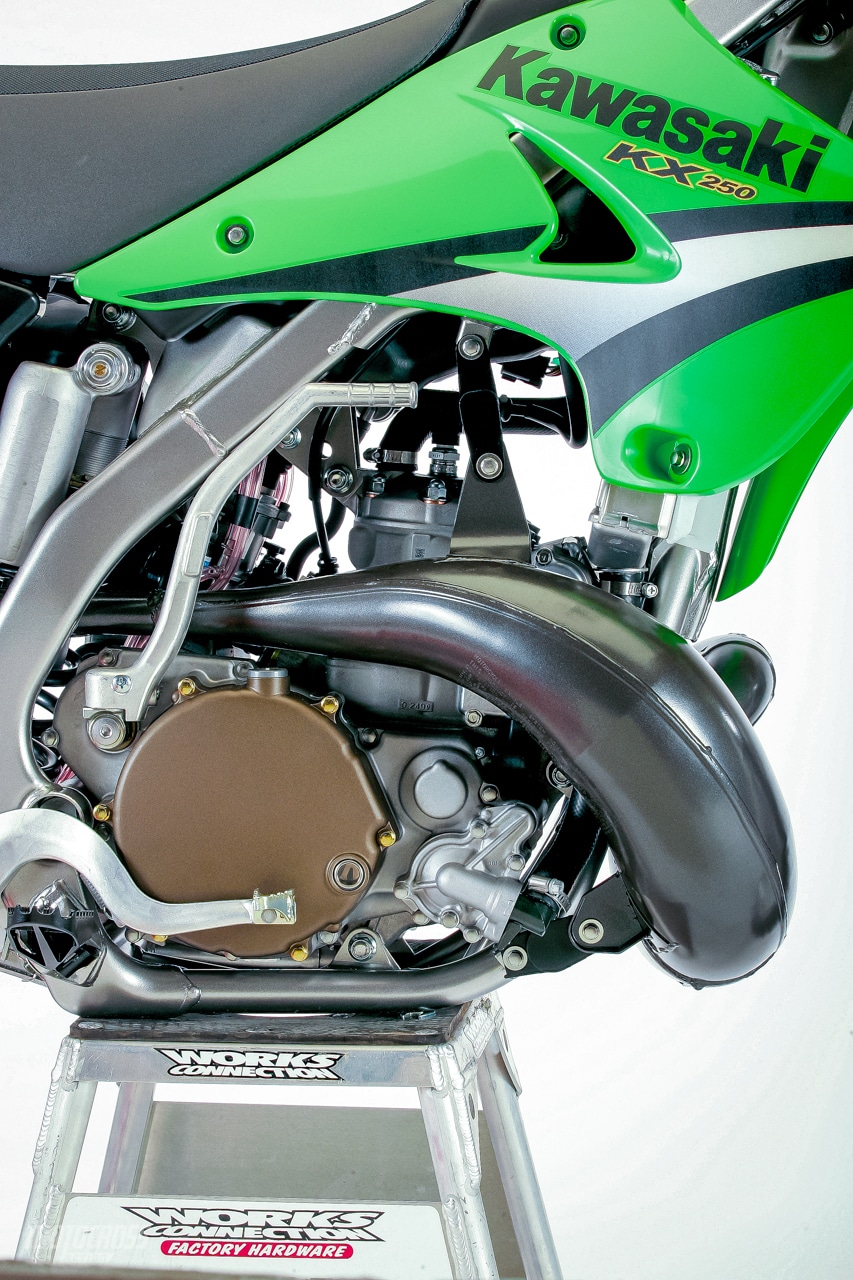
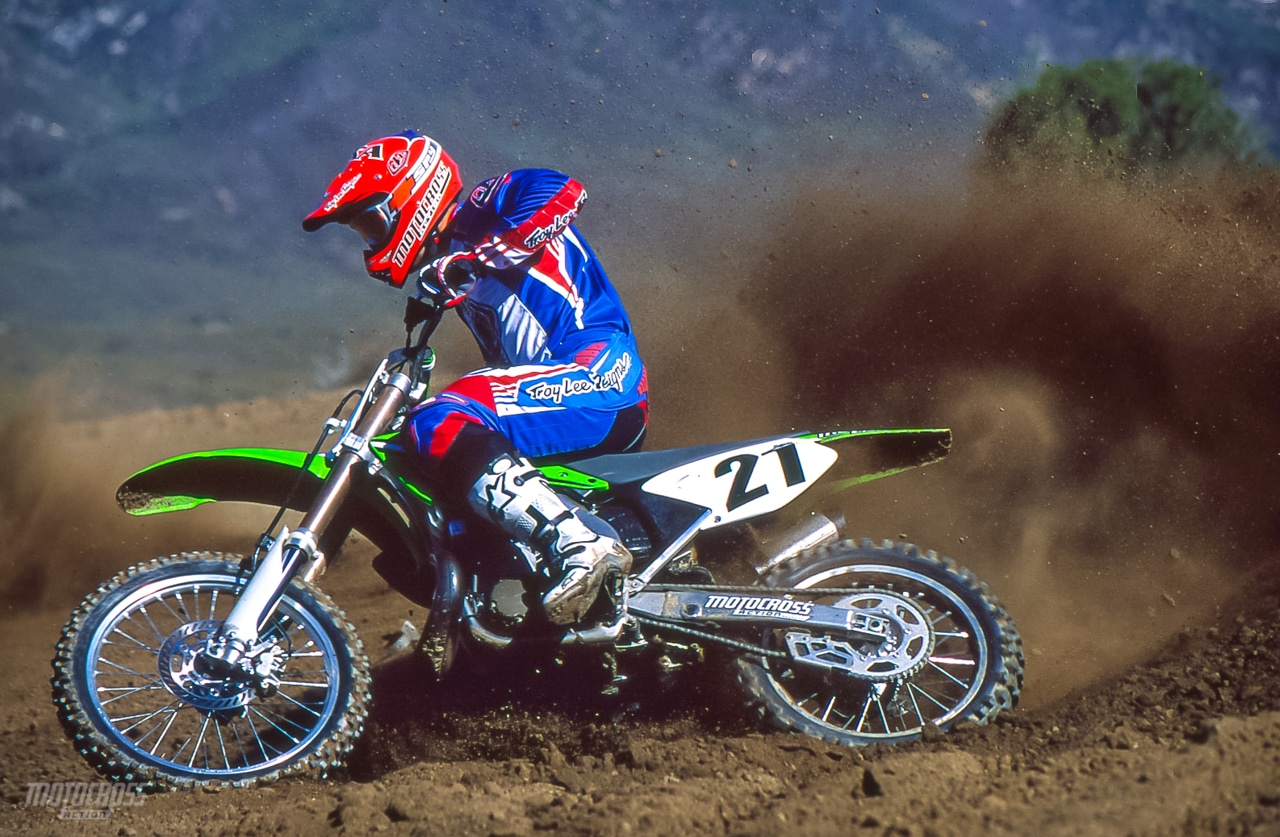
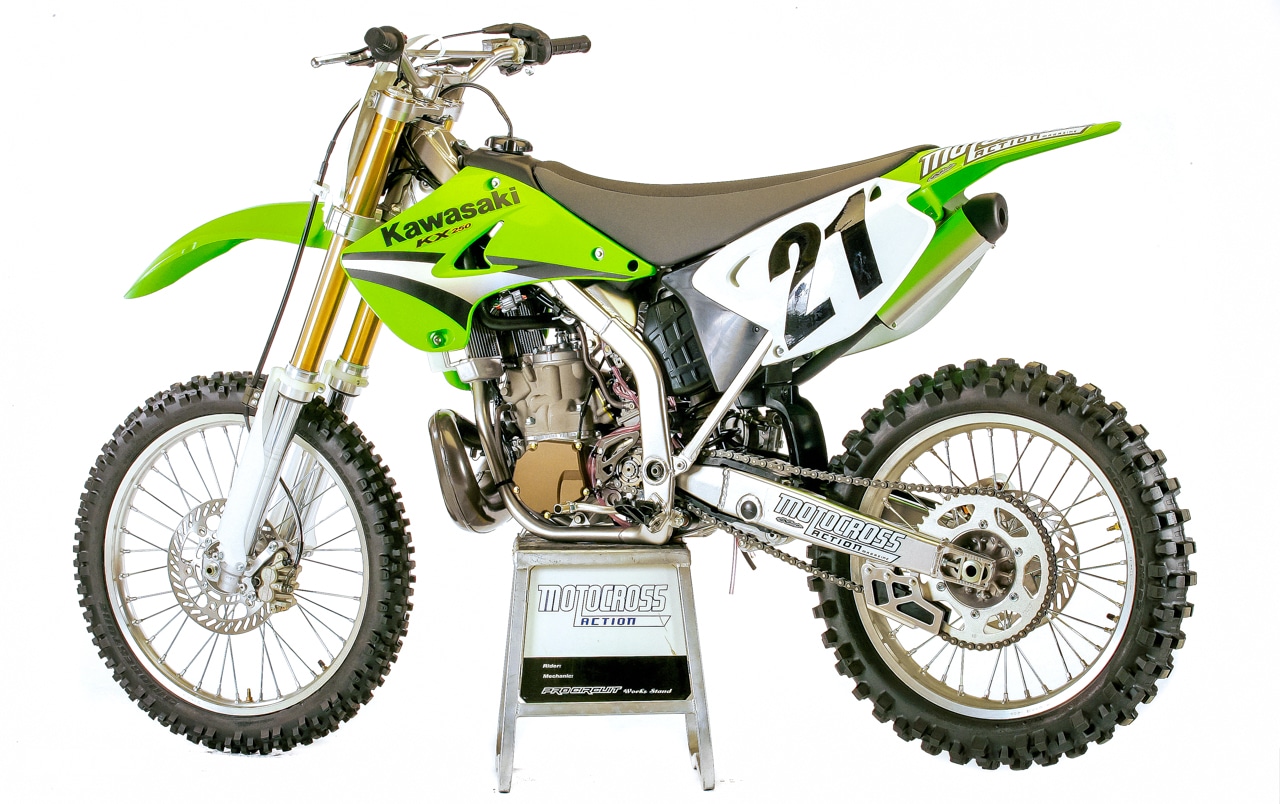
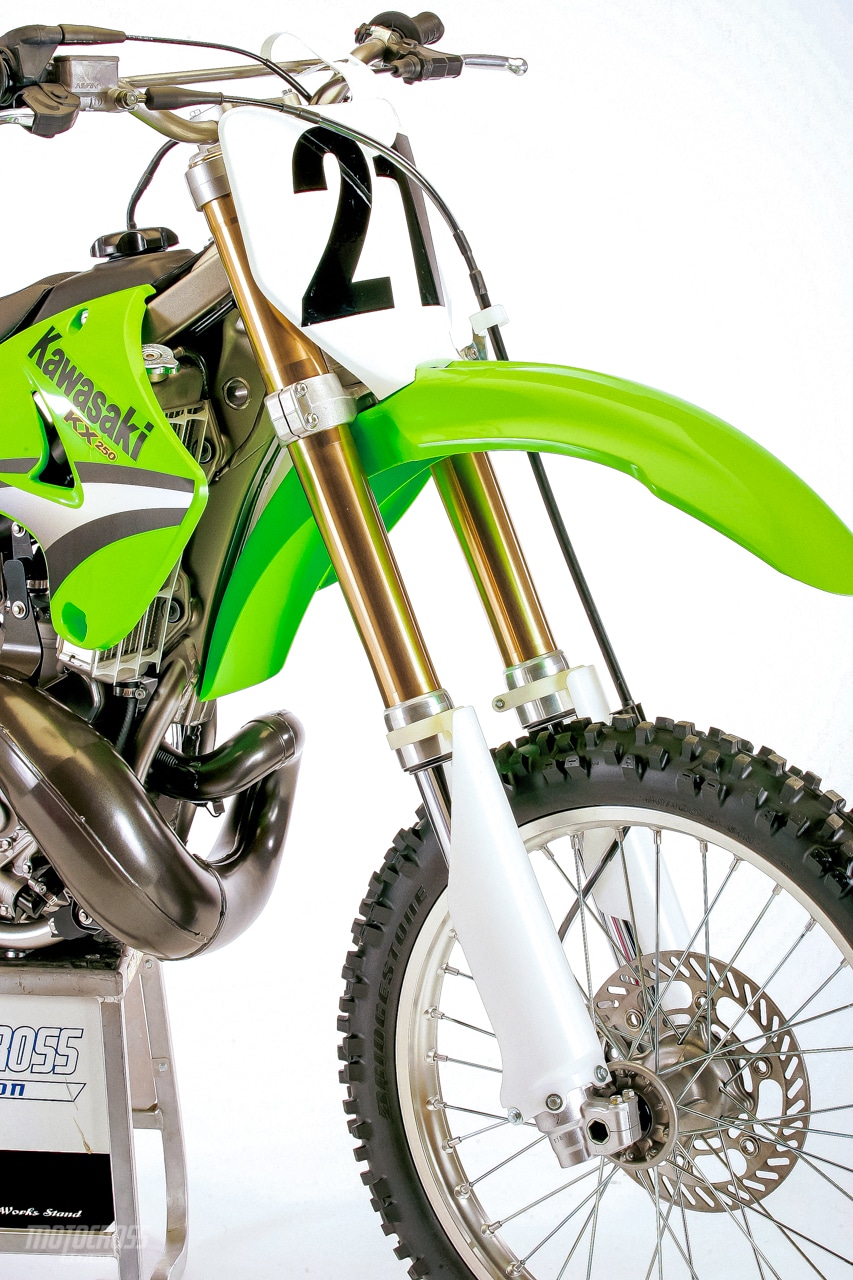

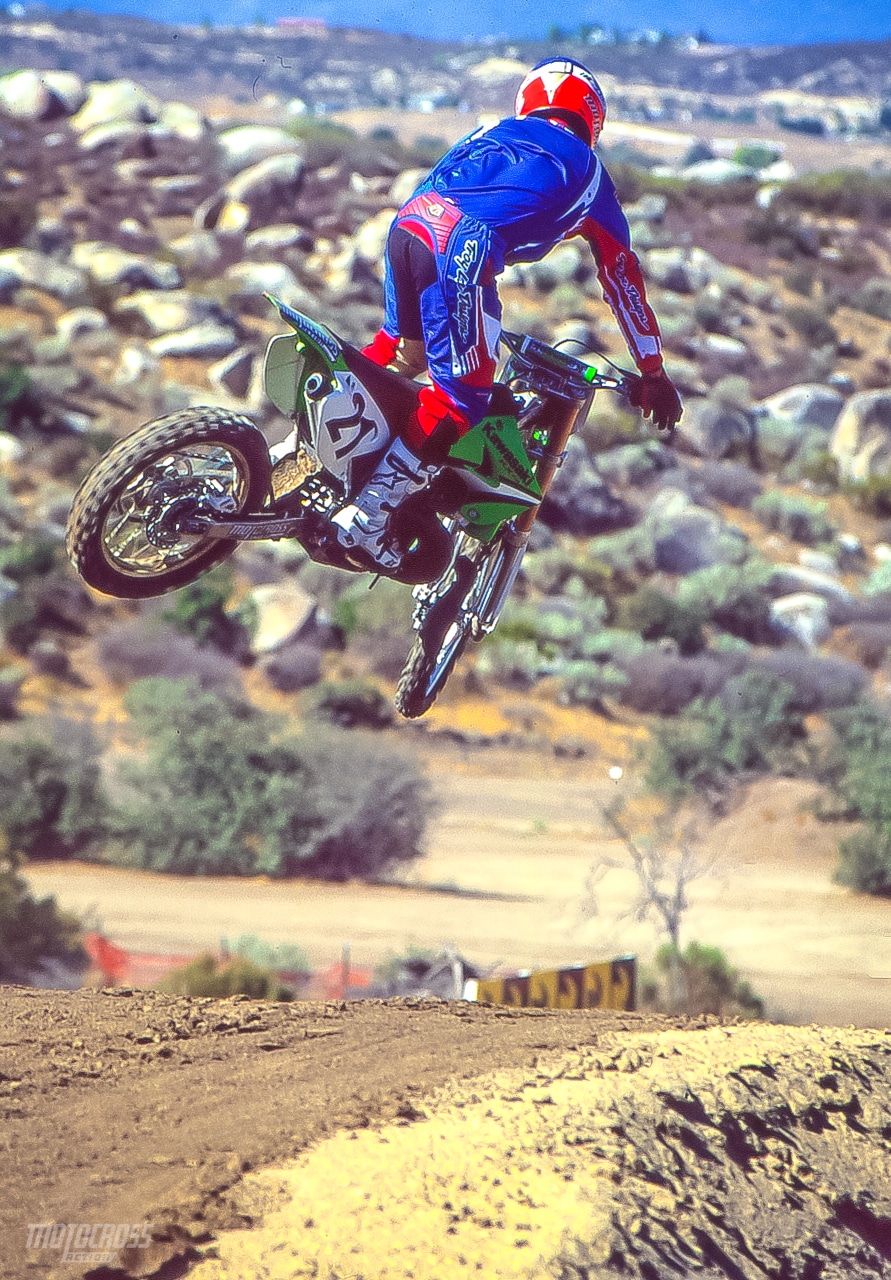



Comments are closed.